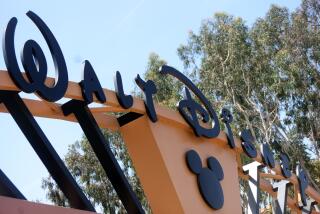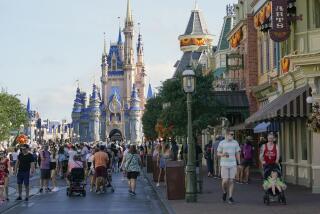Disney Says Profit Up, Confirms Plan to Cut 4,000 Jobs
- Share via
Walt Disney Co.’s second-quarter operating results exceeded Wall Street’s expectations as the company’s studio and consumer products units improved, although Disney did post a net loss stemming largely from a one-time charge to restructure its Go.com Internet portal.
Separately, President Robert Iger confirmed in an interview that layoffs will be needed to reach Disney’s goal of cutting 4,000 jobs companywide.
Iger said voluntary severance package offers are being taken by a “significant percentage” of workers, but not enough to reach 4,000.
“We always expected that,” Iger said, declining to disclose a specific number. He added that Disney believes it will be flooded with requests as the Friday deadline for employees to make a decision approaches. Disney is cutting about 3% of its 120,000 employees--as many as 1,400 from the company’s theme parks.
The company also confirmed that it is shrinking and cutting costs in its venerable animation division. The Times reported Tuesday that company plans to cut staff and trim salaries in the division to improve profitability, with union officials estimating as many as 300 of about 1,000 workers in Burbank could be affected.
“We are able to improve an already profitable business by looking at the cost of that labor” Chief Executive Michael Eisner said when asked about it in a conference call with analysts. “We’re pretty pleased with ourselves that we are managing it financially as well as creatively.”
As for Disney’s earnings, the company’s operating profit rose 33% in the quarter to $391 million, or 19 cents a share, for its second fiscal quarter ended March 31, well above Wall Street’s estimate of 13 cents a share.
Overall, however, Disney posted a net loss of $567 million due to $996 million in one-time charges, $862 million of that from its decision to restructure Go.com.
Disney’s revenue for the quarter fell 4% to $6 billion. Studio operating income rose to $164 million from $46 million due in part to stronger video and DVD results with such titles as “Lady and the Tramp II: Scamp’s Adventure” and “Remember the Titans.” The studio unit also had the profitable “Recess: School’s Out” and did not suffer a major box-office disappointment as it did a year earlier with “Mission to Mars.”
Disney’s consumer products unit, one of its most troubled divisions of late, showed a 30% increase, to $90 million in operating profit, reflecting cost cuts as well as sales from “Aladdin” and “The Emperor’s New Groove” interactive games.
But Disney’s theme park income was flat at $331 million, reflecting lower attendance at Disney World and costs to open Disney’s California Adventure in Anaheim. The company’s media networks group, which includes the ABC network, were off 9% to $489 million, reflecting softer advertising and lower ratings.
Salomon Smith Barney analyst Jill Krutick said results from Disney’s two cyclical businesses--television and theme parks--were weaker than expected, although results from the studio and consumer products were stronger.
Separately, Iger also reiterated the growing optimism in Hollywood that studios can reach a new contract with the Writers Guild of America without a strike. With the contract expiring next week, the two sides have been trying to work out a new deal this week.
In other media earnings:
* Viacom Inc.’s results were higher than expected, in part because of the film “Save the Last Dance” and the hit CBS show “Survivor: The Australian Outback.” Earnings before interest, taxes, depreciation and amortization--a key performance measure used by Wall Street to evaluate media companies--was $1.15 billion in the quarter, compared with $1 billion a year earlier.
* French media giant Vivendi Universal, owner of Universal Studios, said its media and communications earnings nearly doubled to $848.6 million in the first three months of 2001.
* Publisher Primedia said that its first-quarter loss widened to $85.8 million, or 54 cents a share, after the payment of preferred dividends, from $39.4 million, or 35 cents, a year ago.
*
Reuters and Bloomberg News were used in compiling this report.
More to Read
The biggest entertainment stories
Get our big stories about Hollywood, film, television, music, arts, culture and more right in your inbox as soon as they publish.
You may occasionally receive promotional content from the Los Angeles Times.










